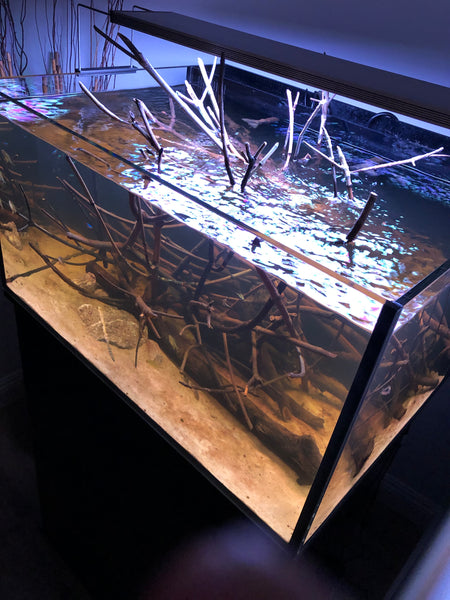- Continue Shopping
- Your Cart is Empty
Pushing through...
There seems to be a stage in all types of aquariums where stuff sort of “challenges” you in some way…Maybe the tank is settling in and showing signs of algae growth. Perhaps, as in our case, there is a lot of biofilm or fungal growth starting to show. Stuff which challenges our aesthetic preferences, or makes us doubt the validity of our plans..

These are things that make or break our hobby...those things which challenge our fortitude. And how we face them...how we deal with them, or accept them- is where the magic lies.
In botanical-style aquariums, we see this a lot.
Almost all of of my botanical-style aquariums hit a stage, early on in their evolution, in which the tank looked...well, kinda bad.

What we expect in our world is that stuff will start out with lots of cloudiness, turbidity, and fungal growths. And it's a bit nerve-wracking to see your perfectly-thought-out display starting out as a cloudy, biofilm-and-fungal-growth-wracked ecosystem.

It takes time. And patience.
Two factors which aquarists are always seemingly challenged by. Remember, botanical-style aquariums are not static. They are NOT like planted aquariums, in which you can achieve a near-desired result from day one, by simply packing your tank with plants of the type and size that you're envisioning in your finished product.

Rather, these systems take weeks, even months, before they start looking like we might envision them. You need to take a very long term view.

And it's easy to think about this as you would a natural aquatic system. Remember, natural systems are constantly changing and evolving as external factors, such as weather, additions of materials from the surrounding terrestrial environment, and internal ones, such as the migration of fishes into and out of them, or the growth of biofilms and other epiphytic life forms. The fundamental changes which occur as terrestrial habitats transform into aquatic ones are also responsible for so many changes.

It's easy to lose sight of the fact that many of the "barriers" which challenge us, and often even leave us discouraged- are but mere "stepping stones" on the long journey towards a stable, attractive, ecologically diverse closed ecosystem.
Yet, we see those things happen in our tanks, and we worry. And occasionally, we doubt ourselves.
I believe that every hobbyist, experienced or otherwise, has those doubts; asks questions- goes through the "mental gymnastics" to try to cope: "Do I have enough flow?" "Was my source water quality any good?" "Is it my light?" "When does this shit go away?" "It DOES go away. I know it's just a phase." Right? "Yeah, it goes away?" "When?" "It WILL go away. Right?"
I mean, it's common with every new tank, really.
The waiting. The "not being able to visualize a fully-stocked tank "thing"...Patience-testing stuff. Stuff which I- "Mr. Tinted-water-biofilms-and-decomposing-leaves-and-botanicals-guy"- am pretty much hardened to by now. Accepting a totally different look. Not worrying about "phases" or the ephemeral nature of some things in my aquarium.

Because I know. I've made the mental shits. I accept what happens. And I understand that it's often "just a phase"- part of the process. And I enjoy watching Nature do her work.
You should, too.
Make it a point, when you start out with a botanical-style aquarium, to understand what to expect. Consider what happens in Nature, and use that as your "barometer."
Enjoy every phase.

Push through early doubts.
Todays simple, but easy-to-forget idea that we all need to remind ourselves about from time to time.
Stay resilient. Stay brave. Stay engaged. Stay creative...
And Stay Wet.
Scott Fellman
Tannin Aquatics
2 Responses
Scott Fellman
LOL, yeah, I understand the whole “messy” ideas…I think again it’s about our tolerances and patience…and willingness to deal with this stuff for a period of time until things settle out. I have a strange ability too tolerate this kind of stuff, lol
-Scott
Joshua E Morgan
This reminds me of my 5 gallon licorice gourami tank…I had the hairbrained idea to use peat moss as the only substrate component. It took DAYS to settle, and until then the tank was a mess :( Note to self; if I EVER use peat moss again, either cap it with sand OR soak the stuff for a week or more before using it. And use the canadian stuff (which is more sustainably harvested than other peat mosses…I did some research and found that apparently peat moss in canada is harvested at a rate that is a mere 60th of how much canadian peat bogs produce each year).






Scott Fellman
Author